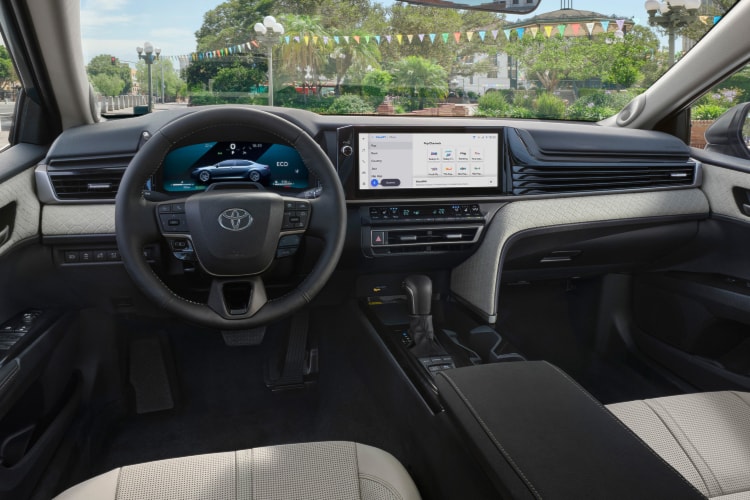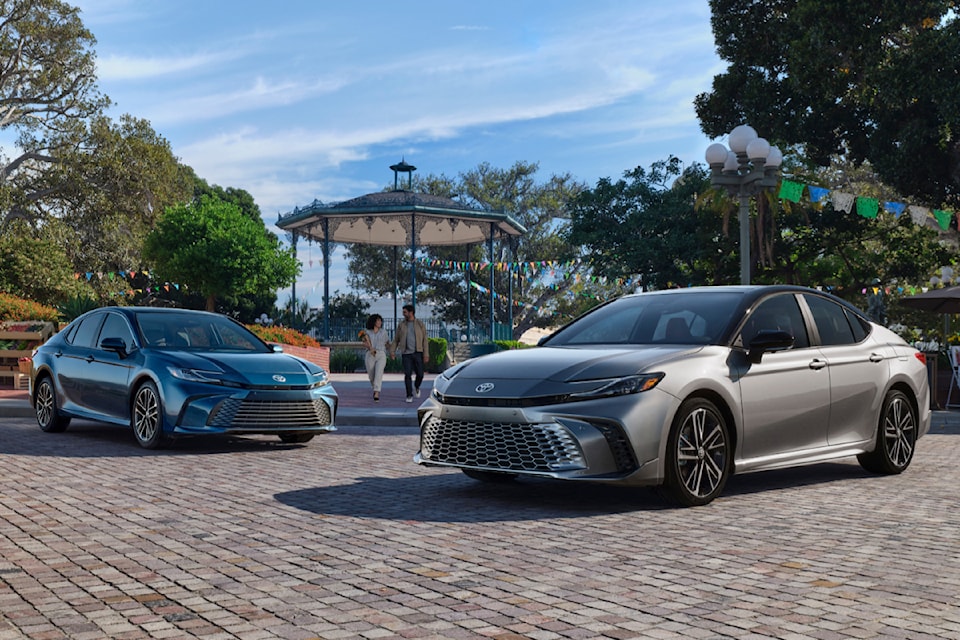The Toyota Camry sedan has been a runaway hit for Toyota, which will no doubt continue with the arrival of the 2025 version.
Since launching in North America 41 years ago the midsize sedan quickly attained top-seller status in its class.
For 2025 the ninth-generation Camry benefits from numerous changes and improvements. The new body styling now exudes a more sophisticated air, primarily due to the cleanly shaped grille and headlights. In back the adjustments are less dramatic, save for a more discrete set of taillights.
Since the new Camry’s platform carries over from 2024 there are virtually no differences between the two sedans in length, width, height and in distance between the front and rear wheels. Likewise, cargo volume and seating capacity are pretty much identical. There are minimal size differences between the Camry and its closest rival, the Honda Accord, except for the latter’s slightly larger trunk capacity.

The redesigned dashboard offers a 7.0-inch digital gauge cluster and an 8.0-inch infotainment screen on base models while a 12.3-inch gauge display and an equal-size infotainment screen is standard on upper trim levels. Apple CarPlay and Android Auto are standard with both screens. The interior’s front and rear seats have been reshaped and the headrests have been softened for increased comfort.
Easily the most significant change has occurred beneath the hood. Toyota has done away with the optional 3.5-litre V-6 that pumped out 301 horsepower and 267 pound-feet of torque. It has been replaced by a new hybrid system that uses a 2.5-litre four-cylinder engine. The front-wheel-drive Camry SE’s two electric motors deliver a combined 225 horsepower and 163 pound-feet. All-wheel drive, which is available on the SE trim and standard on the XSE and XLE, adds a third electric motor in back to power the rear wheels. It’s rated at 232 horsepower and the same 163 pound-feet of torque. AWD versions also get Normal, Eco and Sport drive-select modes.

A 0.6-kilowatt-hour lithium-ion battery pack is standard with both hybrid versions, as is a continuously variable transmission (CVT).
Official fuel consumption for the front-wheel-drive Camry is 4.9 l/100 km in combined city/highway driving. That number increases slightly to 5.1 l/100 km for all-wheel-drive models.
Camry pricing starts at $37,900 including destination charges for the base SE FWD. It’s not exactly a stripped-down model and is equipped with dual-zone climate control, power adjustable driver’s seat, wireless phone charging, six-speaker audio system and five USB ports.
The XSE trim adds a sport-tuned suspension, aluminum sport pedals, leather seats with power adjustable passenger seat, nine-speaker JBL audio package, head-up information display, panoramic moonroof and 19-inch wheels (16s are standard). The XSE also gets a unique sport-mesh grille and black rear spoiler.

Along with the larger gauges and display screen the top-rung XLE comes with interior LED ambient lighting, leather-trimmed heated front seats and acoustic noise-reducing front and side glass.
All Camrys are equipped with Toyota’s Safety Sense 3.0 that now includes blind-spot monitoring with rear cross-traffic alert plus items such as pedestrian detection, lane-departure warning driver-assist that provides light braking and steering support while turning. A 360-degree surround-view camera is standard on XSE and XLE trims.
Our Camry XSE test vehicle provided plenty of cabin space in a quiet and comfortable environment. The 2.5-litre I-4/electric motors combo, while not a performance standout, easily generates more than sufficient power off the line or when accelerating up to freeway speeds. The Camry also felt exceptionally (and surprisingly) agile and secure in the curves.
The electrified Camry is big step for Toyota since for the first time it deletes gasoline-engine choices. However, it should impress sedan buyers seeking to maximize fuel economy and who aren’t yet ready to embrace battery-electric propulsion.



